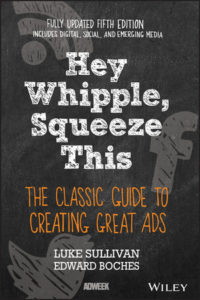 “Hey Whipple, Squeeze This” Review & Summary
“Hey Whipple, Squeeze This” Review & Summary
Sixteen years ago, an eccentric young man (me) started classes at a small vocational school in Minneapolis to learn how to be an advertising copywriter. He was handed a paperback book called “Whipple” and told to study it closely. At the same time, many other people in school and in ad agencies were studying the book closely. It helped form the intellectual foundation upon which our careers were built.
“Hey Whipple, Squeeze This” is written by Luke Sullivan, a well-regarded advertising creative director who spent many years working at top ad agencies in the Midwest and South. Currently, Luke Sullivan is a professor of advertising at the Savannah College of Art and Design. Five editions of “Hey Whipple” have been published. The latest includes a couple chapters on digital and social media written by Edward Boches, a longtime New England-based creative director who now teaches at Boston University.
The major themes found throughout the book are as follows:
Advice for Newbies
Ad pros have to be productive every day, do great work, meet deadlines, make presentations, play well with co-workers, and impress clients. Often under pressure in a viciously competitive industry. Whipple is primarily intended as a guide for advertising students and junior employees. As such, throughout the book one can find advice and insights on surviving and thriving in the ad business. This advice is also good for seasoned professionals. Even people who have been in the business for decades benefit from reading ”Whipple.”
The Process
Advertising is about ideas: coming up with them, sorting the good ones from the bad, making the ideas into ads, and putting them out in the world. “Hey Whipple, Squeeze This” offers priceless insights on the entirety of the process. Especially on sorting good ideas from bad, and making good ads even better.
Writing and Designing
Luke Sullivan comes from a copywriting background, and offers excellent tips for copywriters of all levels. In fact, many seasoned copywriters (such as the writer of this review) use “Whipple” as a reference as we’re writing headlines, body copy, and scripts. Though “Whipple” has many tips on design and art direction, it is not a design textbook. But it is still valuable for art directors and designers.
 Smart Business Sense
Smart Business Sense
Despite the creative nature of the business, advertising is still a business. Our work has to solve our clients’ problems, most often by boosting sales. What’s more, we must present our work so that it instills client confidence if we want to have any hope of our ideas being produced. Much of the guidance in “Whipple,” in one way or another, reflects the reality that advertising is a service business. I have no doubt account directors have been able to point at positive numbers after a copy of “Whipple” got passed around the agency.
Print, TV, and Radio
When “Whipple” was first written, print was a far more dominant ad medium than it is now. However, a decreasing share of the budget does not decrease its importance. Print is the simplest and clearest demonstration of ad-making fundamentals. The lessons learned from making a good print ad apply to every other medium.
TV advertising has long been perceived as the most glamorous, most expensive, and most persuasive ad medium. However, the amount of money and energy poured into TV certainly does not result in very many good TV ads. “Whipple” has guidance on making sure TV ads inspire, rather than repel, the customer. All the advice here is also applicable to online video, which might be the most ubiquitous form of creative advertising soon.
Radio advertising often seems like an afterthought. But any ad worth doing is worth doing well – and copywriters should put a particular emphasis on getting good at radio. Sullivan’s guidance on radio is excellent and is one of the better parts of the book.
Digital and Social
The fifth edition of “Whipple” has lengthy and example-packed chapters on digital and social media. These sections focus on the perspective creatives need to approach digital and social, and the elements of campaigns that make them successful. It is clear Sullivan and Boches wanted to make sure the sections on old-school traditional advertising worked in tandem with the sections on new media. Another new section on creative briefs and collaboration between creative and digital teams feels cliché, but I can understand why they needed to put it in the book.
Advertising Agency Culture
Advertising agencies are famous (or notorious) for fostering un-corporate cultures. The industry is seen as a haven for fun, creative oddballs. Sadly, advertising culture also indulges some primadonnas, political hacks, and bullies. “Whipple” is full of hilarious stories from Mr. Sullivan’s days in the trenches, and thoughts on navigating around the strong personalities. This might be the most important part of the book for juniors, because the challenges they face in an ad agency have all happened before and will happen again.
Career Development
There is a very strong section in the book on how students should go about putting their portfolio together and get their first job. The advice on portfolio websites is targeted at students but is applicable to creatives at every level. For creatives with some experience under their belt, there is less direct advice. But following the overall insights throughout the book will surely boost your career development.
Hold Your “Whipple” Close
“Hey Whipple, Squeeze This” is a classic for a reason. Many of the best creatives I’ve worked with in my career were intimately familiar with the book. The advertising business has completely changed since it was first published. But the fundamentals of good advertising do not change.
Years from now, eccentric young men and women will start class at colleges and advertising schools around the country. They will be handed a paperback book called “Whipple” and told to study it closely. It will help form the intellectual foundation upon which their careers will be built.
bfw Learns from the Experts to Deliver Great Work
Just as every successful professional must seek inspiration for constant improvement, so do we. To hone our craft, we revel in the work of famed experts in many industries. Our thinking, writing, and design combine with sound strategic insights that anticipate consumer desire. The result? Great advertising that works for our clients.
bfw is a tight knit collection of writers, artists, designers, technologists and thinkers who share a common passion for doing great work that makes things happen. For more information call (561) 962-3300 or visit www.gobfw.com.